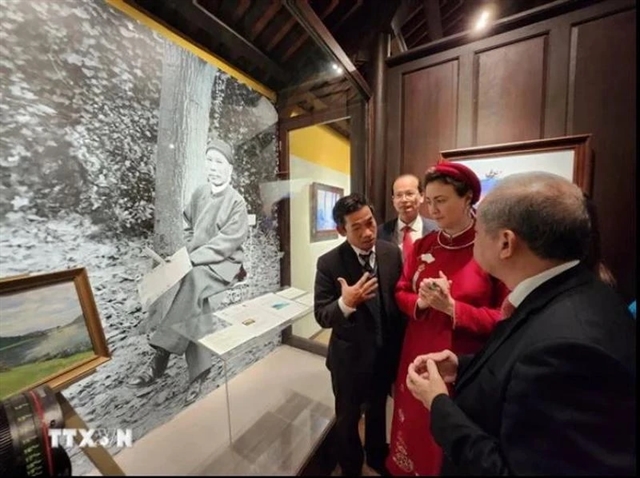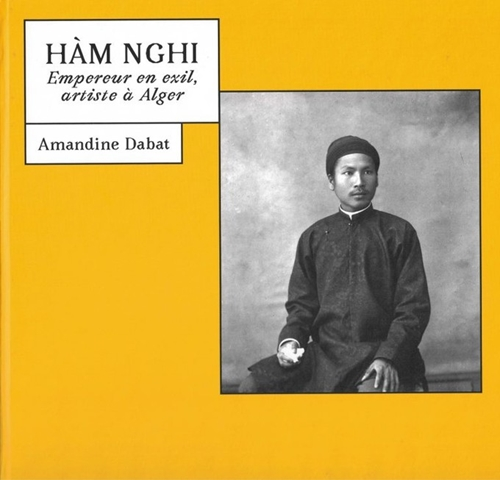 Life & Style
Life & Style

 |
| qaAmandine Dabat (in red), a fifth-generation descendant of King Hàm Nghi, and officials of Thừa Thiên - Huế Province visit an exhibition on the king. — VNA/VNS Photo |
HÀ NỘI — The Vietnam Fine Arts Museum is about to receive a painting titled Hillsides in Deli Ibrahim (Algiers) by Hàm Nghi, an exiled Vietnamese king, on November 12.
Hàm Nghi (1871-1944), personal name Nguyễn Phúc Minh, came to the throne in 1884 and was the 8th king of the Nguyễn Dynasty (1802-1945). After the Imperial City of Huế was lost in 1885, he left the capital and issued the "Cần Vương” (Aid the King) edict, calling for patriots to rise up to regain independence and freedom. He was detained by the French colonialists in 1888 and exiled in Algiers, the capital of Algeria, the following year.
He lived at a villa on El Biar hill, about 12km from Algiers, and still upheld the homeland’s traditions until his death in January 1944.
During the years of exile, the king learned painting and sculpture, following the art movements of impressionism and post-impressionism. He created 91 paintings along with a number of sculptures. Many of his works became known in the art world through auctions and exhibitions in France.
The oil painting Hillsides in Deli Ibrahim (Algiers) was created in 1908, depicting the countryside landscape near his home in Algiers. In 1926, the work, given that title and signed Tử Xuân, was displayed at the Mantelet-Colette Weil gallery in Paris.
The museum said this painting will be presented by PhD in art history Amandine Dabat, a fifth-generation descendant of King Hàm Nghi, with the hope that the public in Việt Nam and international visitors can admire this work by the exiled emperor and artist right in his homeland.
Hillsides in Deli Ibrahim (Algiers) not only enriches the museum’s collection but is also a precious source of reference for researchers of Vietnam’s fine arts in the late 19th century and the early 20th century, the museum noted.
Book launch
 |
| The cover of the book 'Hàm Nghi – Exiled Emperor, Artist in Algeria'. |
The book Hàm Nghi – Exiled Emperor, Artist in Algeria was launched on November 5 in Huế imperial city, the central province of Thừa Thiên - Huế, shedding light on the exiled Vietnamese emperor’s artistic legacy.
The book was published in Vietnamese last month, as a 500-page volume, compiled by Dr. Amandine Dabat, Hàm Nghi’s fifth-generation descendant. The book explores the dual identity of the emperor as a patriot and an artist during his exile in France and Algeria. Originally published in French by Sorbonne Press in 2019, the book features 71 pages of artwork, 12 pages of sculptures, and 68 pages of archival photographs and correspondence.
Dabat's research was drawn from two major collections: a private family archive of 2,500 documents, including Hàm Nghi's personal correspondence during exile, and administrative records from the Algerian government stored at France's national overseas archives.
At the book launch, Hàm Nghi's descendants donated several royal artifacts to the Huế Royal Antiquities Museum under the Huế Monuments Conservation Centre, including mother-of-pearl inlaid wooden trays, royal chopsticks made of walrus ivory, and imperial porcelain items used during his reign.
Hàm Nghi was trained in fine arts by painter Marius Reynaud from 1889. He started learning sculpture from Leon Fourquet in Algiers in 1895 and from Auguste Rodin in Paris in 1899 (in three summer months every two years).
The king used pseudonym Tử Xuân as it was his nickname when he was small, and he also used it as his name for his entire life. — VNA/VNS




